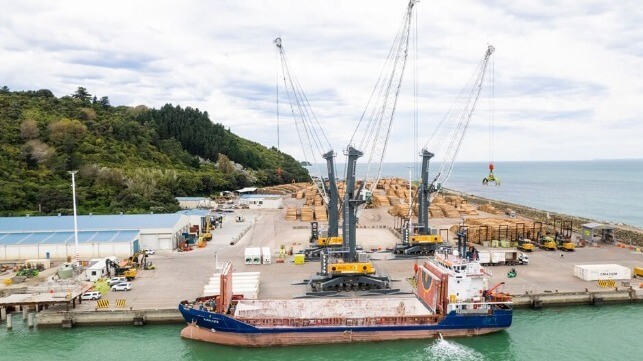Port Handles First Containers in 40 Years in Cyclone Relief Effort

It is not often that you hear a port say it is handling containers for the first time in 40 years. New Zealand’s Eastland Port on the North Island, however, is doing just that as part of a support effort to help the local communities in response to Cyclone Gabrielle which hit the region hard.
Located in Gisborne City, Eastland Port is New Zealand’s second-largest log export port handling three million tons of wood each year. The port, however, has not been serving coastal shipping for more than 40 years. This all changed today, March 21, when a chartered vessel, the Rangitata (1,650 dwt), docked for the first time to open the new vital link which the Regional Economic Development Minister Kiri Allan told the New Zealand Express will be a “blue highway.”
Tropical Cyclone Gabrielle formed in early February moving across the North Island of New Zealand leaving a path of destruction in its wake. Eleven people were killed and thousands displaced with reports indicating that the aftermath of the storm could cost NZD$13.5 billion (US$8.4 billion) in long-term repairs. At its peak, maximum winds exceeded 90 mph with massive amounts of rain and flooding before the storm moved on to impact both Vanuatu and Australia.
Remote communities and businesses on the North Island are suffering from the aftereffects. One of the main roads in the region is washed out with no definitive timeline for when it can be reopened. In response with farmers and other businesses struggling to move their goods, port and local government officials began lobbying for the blue highway to support the community in the aftermath of the storm.
The port’s chief operating officer Andrew Gaddum told the New Zealand Herald the effort would be “a game changer.” He cites the fact that freight routes have been severely disrupted with the few trucks that can travel required to take long, circuitous routes dramatically increasing the time and cost of moving their goods.

Containers are being moved via coastal shipping as part of the cyclone relief effort (Drone images by Brennan Thomas, Strike Photography - Courtesy of Eastland Port)
The Eastland Port is underwriting the effort investing approximately US$1.4 million including converting parts of the Gisborne log port to handle products ranging from meat to fruit and vegetables. Cranes had to be repurposed from moving logs to handle the containers, generators had to be supplied for the refer boxes, and operators had to be trained. Gaddum said it has been “a monumental learning curve,” but thanked everyone’s effort and support including the Napier Port which will be the other terminus for the blue highway. The government provided a grant of just over US$300,000.
The 16-year-old general cargo ship Rangitata has been chartered for three months. The 220-foot vessel which is registered in New Zealand is able to transport containers, including refers, which will be perfect for the farmers to move the local meat and produce to market.
“The Rangitata made history yesterday being the first container ship we’ve seen at Eastland Port in decades,” reports port executives after the vessel’s arrival. “It’s great to see the return of containers to our port and we are excited to be doing our bit for the region in terms of shoring up our resilience.”

that matters most
Get the latest maritime news delivered to your inbox daily.
The vessel brought in an initial shipment of thirteen 40-foot empty containers and loaded thirteen 40-foot full containers with meat and fresh produce. She departed late on March 21 heading to Napier and will return later in the week with 17 more containers.
While it is the first time in many years that commerce has traveled by coastal shipping, port officials hope it might continue beyond the immediate relief efforts. They are already speaking with local businesses to gauge interest in maintaining the service highlighting that they believe it can be cost-competitive and good for the environment by removing diesel trucks from the roads.
